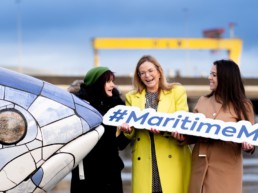We are offering 5G funding competition applicants up to three days of free expert consultancy support, provided by Spirit Public Sector, to help develop their 5G/advanced wireless project. Email innovationfunding@belfastcity.gov.uk to request support – subject to availability.
Tony Sceales from Spirit Public Sector has shared some of his top tips for applicants.
1. Strong bids start with a real-world problem
The best applications we’ve seen so far start by asking “What’s holding us back?”. Then they think about how advanced wireless connectivity can help to remove the obstacle. If you have a challenge around operations, safety, visitor experience, logistics, or service delivery, that could be your starting point. And applicant support is available to shape it into a fundable bid that can deliver maximum impact for your organisation.
2. Set an achievable scope and build a roadmap beyond it
Most applicants are not short of business challenges, and advanced wireless can help solve many of them. The key is to focus your funding bid on a challenge you can credibly deliver within the funding window. That means prioritising what goes into the project now, and what can follow later. Useful criteria include time to deploy vs time to value, delivery certainty, business impact, and narrative strength. A focused scope now, backed by a roadmap for what comes next, is more persuasive than trying to do everything at once.
3. Adoption, not experimentation
Some projects we’ve seen sound like trials, R&D, or testbeds. This fund is for organisations that are ready to put wireless technology into real operational use. That means having clarity about where, when, and how the solution will be used, what difference it will make, and showing that you will put it into live use.
You must be the customer or end user of the wireless technology – not a solutions provider. Suppliers and technology partners can absolutely help shape the project and the bid, but the customer organisation – the one using the solution – must lead the application and take responsibility for implementation.
If you don’t yet have the right partner in place, the applicant support team can help bring customers and suppliers together.
4. These projects are partnerships – no one delivers them alone
It’s not usually realistic for one organisation to handle everything. The strongest bids can involve suppliers, delivery partners, or technology experts who bring the right skills to the table. Collaboration is valuable in deploying the wireless infrastructure, integrating new systems, or supporting change on the ground. If you need support with capability or capacity gaps in your project, the applicant support team can help you to identify the types of partners that may be able to provide support.
5. Your business case doesn’t need to be perfect
You don’t need an extensive business case document, but the competition application assessors do want to see that you have thought through how the project will deliver value and how you will know if it’s working. Even simple metrics like time savings, reduced downtime, improved customer experience, or revenue uplift, can show that the project is grounded in reality.
A clear business case shows how those benefits connect to your organisation’s priorities. That might mean improving staff efficiency, scaling a service, reducing manual processes, or unlocking new revenue. The key is to be specific, measurable, and realistic. If you already use financial or performance metrics internally, including them can help demonstrate that the project fits your usual way of making decisions.
6. Match funding is a hurdle but not a blocker
Applicants must provide at least 30% match funding, but this doesn’t always mean finding new money. Many successful bids meet the requirement by redirecting existing budget lines or staff time. What matters is being clear, consistent, and showing that the funds will be available and used during the project.
Importantly, only spend on implementation before 31 March 2026 counts towards your match funding, and more match funding scores more highly.
7. Delivery planning matters
You need a clear, credible delivery plan with confirmed roles, realistic timelines, and a practical approach to managing change. The biggest red flag for assessors is vagueness: unclear responsibilities, missing risks, or unrealistic assumptions about procurement.
Your project plan needs to go beyond implementation. Assessors want to see how the solution will continue to be used between April 2026 and March 2028 (post funding period), including who will lead day-to-day delivery, how staff will be supported, and how the new technology will be embedded into your organisation.
Show that your project can be delivered and sustained.





